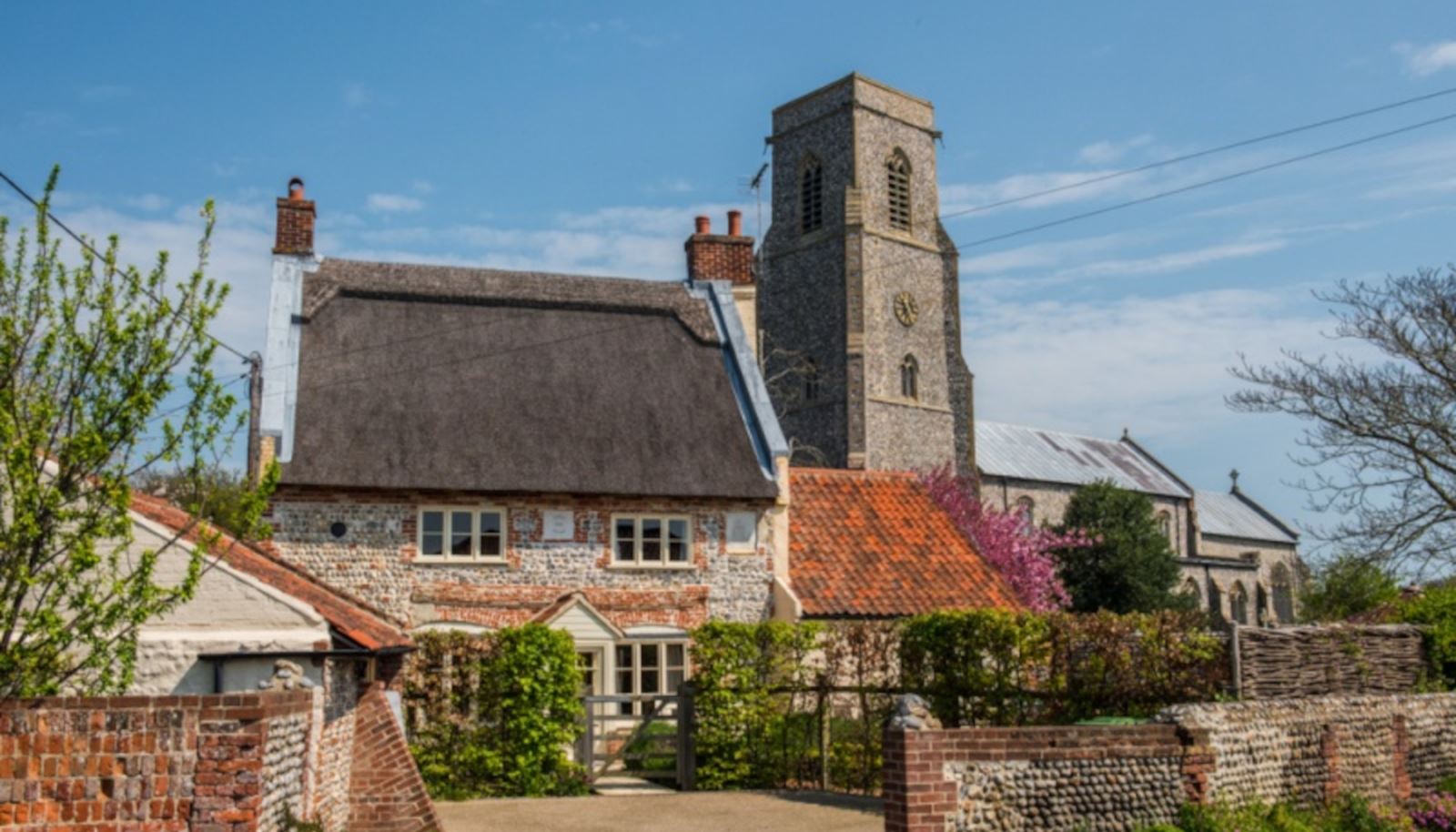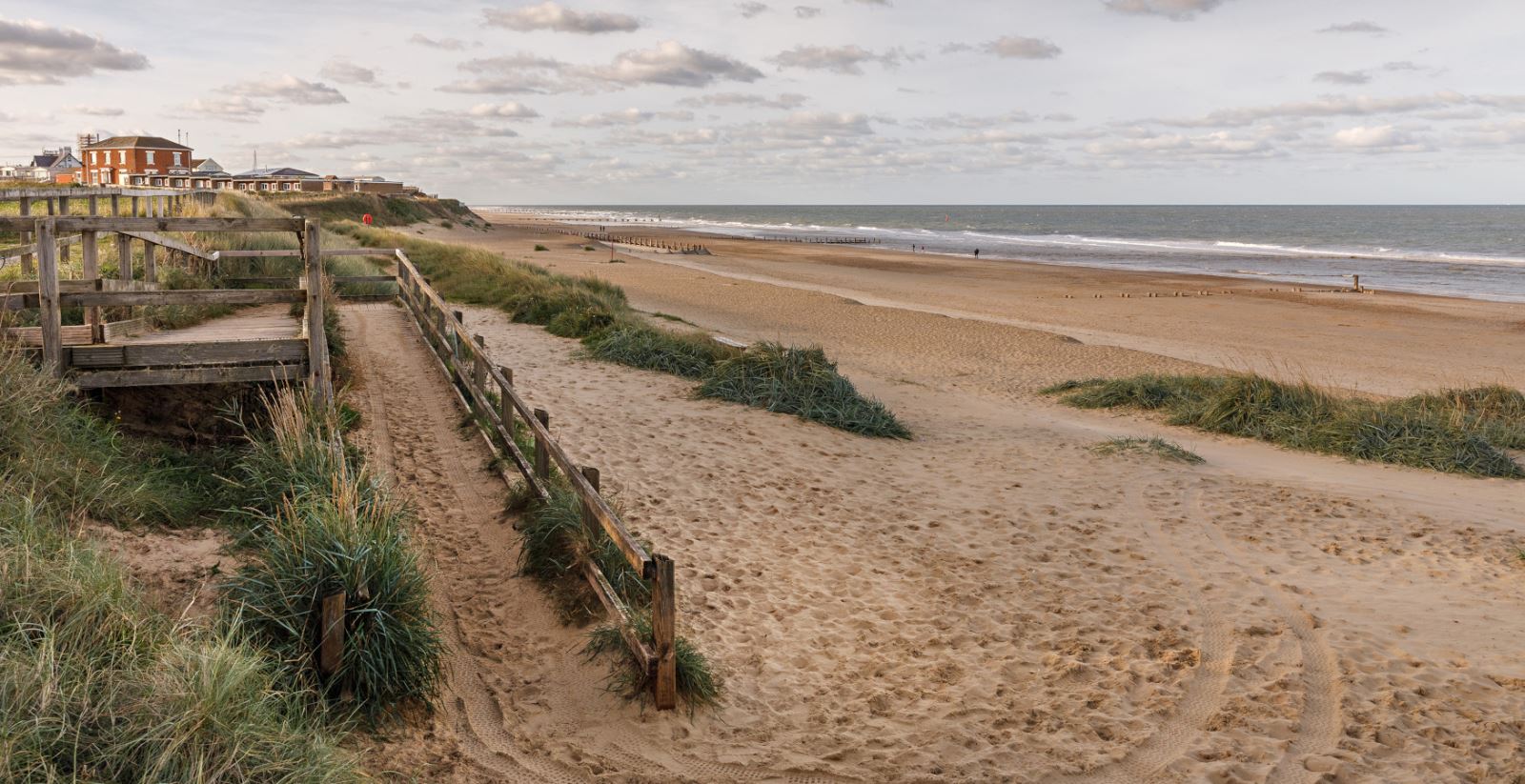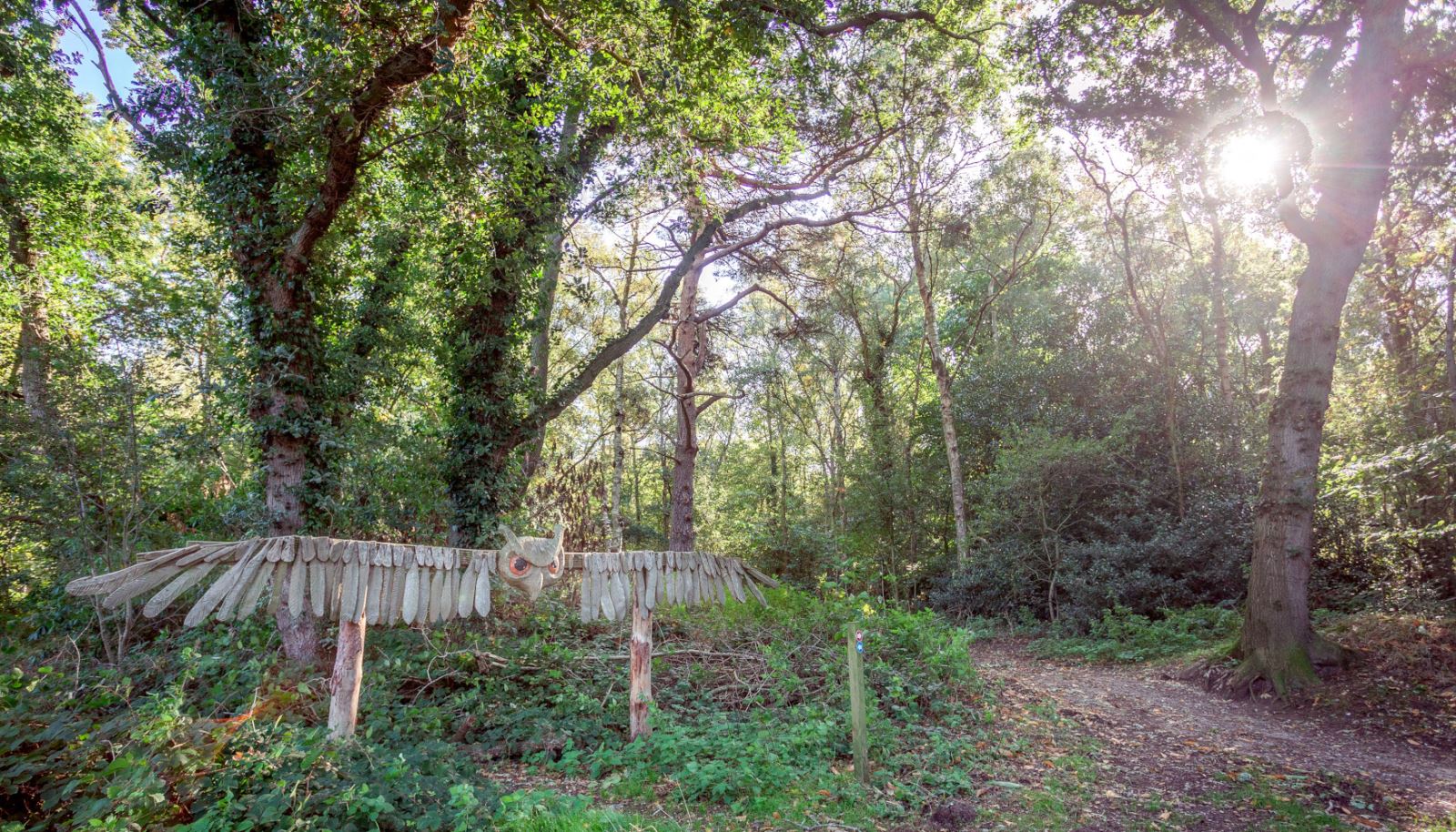North Norfolk has 45 miles of coastline, the Deep History Coast, beautiful countryside, walking trails and charming towns and villages. So, there are plenty of places to get off the beaten track. Plan a trip to escape the everyday and find hidden gems, new places to go and enjoy unique experiences while avoiding the crowds. We’ve uncovered north Norfolk’s paths less trodden and hidden gems so you can find your own piece of north Norfolk to enjoy.
CROMER
The traditional seaside resort of Cromer is famous for its pier, lifeboat station and Pavilion Theatre (where the UK’s only remaining traditional end of the pier variety show takes place). But did you know that Cromer is on north Norfolk’s Deep History Coast and here you will find ‘Britain’s Great Barrier Reef’, the Cromer Shoal Chalk Bed, created in the Mesozoic Era when dinosaurs roamed? It is the longest in the world at 20 miles long. Cromer is on the Deep History Coast Discovery Trail and has its own Discovery Point.
There are golf courses at Cromer and Sheringham and you can try surfing with Glide Surf School alongside Cromer Pier. The Norfolk Coast Path is a fantastic walk and there are other plenty of other paths less trodden you can enjoy.
.jpg)
OVERSTRAND
Overstrand is a quieter beach offering a more peaceful and less crowded day out. Make sure you stop off at the Discovery Point on the Deep History Coast Discovery Trail, where you can find out more about the area’s past as well as use the free mobile app to bring the past back to life!
From Overstrand, you can follow the Deep History Coast Discovery Trail to Trimingham (approx. 3km). Start at the car park at the west end of Overstrand, and follow the broad sea wall promenade at the bottom of the cliffs to its east end, where it turns inland up a gently sloping road. After a short section walking next to the main road the route forks back along a lane past Manor Farm to regain the cliff top path. The path follows the edges of arable fields for much of the way, and can be quite muddy and slippery after rain. It winds and dips right at the top of the cliffs, and in places you'll need to divert several metres inland where it has disappeared completely. Just before you get to Trimingham the path goes through a small but pretty woodland perched right on the top of the cliffs, the only woodland section on the route. Soon after the wood, the path again turns inland to join the main road.
As you walk past the cliffs, you may spot gashes of white which are actually huge chunks of chalk in the wrong place! They are pieces of the 70 million-year-old chalk reef which lies below the sea beyond the beach, which were disturbed by glaciers passing over it during the ice ages. Now they sit in a layer of the cliffs that is probably only a million or so years old. Keep a look out for lines of neat, circular holes in the steeper parts of the cliffs. These are the tell-tale signs that a colony of sand martins has been at work.
.jpg)
DILHAM CANAL
Pack up a picnic, grab your paddle board, kayak, dinghy, fishing rod, swimsuit, walking boots and binoculars and head to Dilham Canal, a rural and peaceful corner of north-east Norfolk! There are easy paths beside the North Walsham and Dilham Canal with links to the neighbouring 23.5 hectare Pigney’s Wood community woodland and the 22-mile Paston Way trail for anyone who fancies a longer hike.
The 19th century waterway is a source of interest in all seasons and you may be lucky enough to spot some of the huge range of flora and fauna recorded along its banks and in the water, including kingfisher, grey wagtail, mute swan, deer, otter, little egret, water vole, and some of Britain’s most endangered moths and dragonflies. There is an off-road parking area beside the mill pond.
.jpeg)
TRUNCH
The quiet village of Trunch, just a few miles from Mundesley, has a small village green, 16th century pub, and a beautiful 15th century church dedicated to St Botolph. The church’s magnificent carved font canopy is one of only four such canopies in all of England. Several fragments of Saxon stones are embedded in the walls which suggests that a church stood in that spot long before the Norman Conquest. The history of the village goes back to the Domesday Book, however archaeological discoveries including a Mesolithic axehead indicates that the area was settled at least as far back as 4000 BC.

WALCOTT AND BACTON
Walcott is a small village on the north Norfolk Deep History Coast situated between Mundesley and Happisburgh. Walcott is the only point where the coast road runs right along the edge of the sea providing great views. This quiet village has a stunning sandy beach backed by a sea defence wall. The beach is often quieter if you want to escape the crowds and it also sits on the Norfolk Coast Path so provides easy access to neighbouring coastal places and stunning seaside walks.
Make sure you stop off at the Deep History Coast Discovery Point here where the free app is triggered enabling you to meet the augmented reality Hominin family who will chat to you about where you are standing. When the Hominins lived there it wasn’t a coast; the land stretched for miles across to Europe and animals such as the fierce scimitar toothed cat roamed the land.
.jpg)
Neighbouring Bacton beach is where a major sandscaping project took place in 2019 to protect the coastline. This pleasant sandy beach is often quiet and uncrowded. The wooden groynes divide up the beach creating great windbreaks and have the effect of creating lots of smaller beaches where you can often spot seals. If you fancy the walk there is a pathway along the coast.

HAPPISBURGH
The village of Happisburgh is situated between Walcott and Cart Gap. This historic village has a secluded sandy beach and a fascinating history showing the earliest signs of humans in Britain. There are Deep History Coast Discovery Points at both places. The beach is dog friendly and great for days out. From here, you can walk as far as Sea Palling taking in wonderful views. The deep history finds here have rewritten history as we knew it. That and the constantly changing coastline, its 18th century lighthouse and 15th century church makes Happisburgh a fascinating place to explore. From the beach there are miles of coastal paths to walk and footpaths in the surrounding area. You can walk to Walcott, Cart Gap and Sea Palling beaches from Happisburgh, as well as follow a 1.75 mile trail around the village taking in the landmarks and historic buildings.
Just a 15 minute drive away, you will find another hidden gem; the RAF Air Defence Radar Museum Neatishead, the country's only original Cold War Operations Room. Housed entirely in RAF buildings, including the hardened Grade 2 listed 1942 radar operations building, the museum provides a unique window into the history of radar covering the period of WW2 to the Cold War. There are 24 exhibition rooms and over 10,000 display items.
.jpg)
NORTH WALSHAM
The market town of North Walsham, became a centre for weaving in the Anglo-Saxon era, along with the nearby village of Worstead (from where the cloth gets its name). The wealth generated, enabled the local people to build the 1330 dated St. Nicholas Church; its tall tower is the second tallest in Norfolk after Norwich Cathedral.
In the market place you can find a 16th century cross with clock, the focal point of the town, which was built to collect rent from the market traders. Today, a weekly market runs and there are plenty of shops, eateries and historical buildings including Paston College where Horatio Nelson, spent his school days between 1768 and 1771. Nearby Memorial Park has a great play area for children.
.jpg)
A short distance away is Bacton Woods with 280 acres of ancient woodland, dating back to Saxon times. The marked trails, through the beautiful woodland, offer great walking routes and terrain for mountain biking.
.jpg)
WALSINGHAM
Just four miles from Wells-next-the-Sea, on the banks of the River Stiffkey, is Walsingham, which has a long history of religious pilgrimage and wealth of historic buildings. The history of Walsingham and its pilgrimages began in the 11th century with the visions of the Virgin Mary by the lady Walsingham, Richeldis de Faverches. She requested that a replica of the Holy House at Nazareth be built at Walsingham which became a place of prayer and reconciliation and one of Europe's four great pilgrim places in the Middle Ages. The pilgrimage season at Walsingham runs from Easter to the end of October.
In the village, you can see many 14th and 15th century buildings including The Shirehall Museum, Walsingham's Georgian Courtroom where you can discover more of the village's amazing history since 1061. Through the museum is the entrance to the Priory Gardens where you'll find the impressive twin turreted 13th century arch, the remains of the medieval priory surrounded by stunning gardens with seasonal flowers. Just a short walk from the museum is Walsingham Bridewell and there are plenty of shops in the pretty village including tea rooms and cafes. Walsingham is also home to the Wells & Walsingham Light Railway, said to be the longest 10-and-a-quarter inch narrow-gauge steam railway in the world.
.jpg)
PRETTY CORNER WOODS, SHERINGHAM
Pretty Corner is a beautiful 165-acre woodland and heathland, which forms part of a larger network of woods and heaths. Together they stretch along the 10-mile Holt to Cromer ridge within the north Norfolk AONB.
Here you will find broadleaf and coniferous trees, heathland, grassland and ponds, as well as veteran trees such as oak, beech and sweet chestnut that date back hundreds of years. Pretty Corner is home to a wide range of animals, birds and creepy crawlies. Look for the fluttering wings of bats, bullfinches, kingfishers, butterflies, owls and woodpeckers. Keep an eye out for the scarlet flowers on the red campion, and the white tips of wood sorrel.
Take a walk to the highest point of Pretty Corner, rising to 96 metres (315 feet) above sea level, making it one of the highest points in Norfolk. At the top you will be rewarded with stunning views towards Sheringham and the sea.

OLD HUNSTANTON
The quiet village of Old Hunstanton is adjacent to the larger, busier resort of Hunstanton or New Hunstanton. Enjoy clifftop walks along the famous stripped cliffs past the Old Hunstanton Lighthouse and the ruins of St Edmund’s 's Chapel, built in 1272. The River Hun runs to the coast just to the east of old Hunstanton and Old Hunstanton is also near the start of the Norfolk Coast path which extends over 40 miles along the stunning coast.
The vast sandy beach, sand dunes and pretty beach huts offer a great day out away from the crowds. This stretch of coast is popular for bird watching and nearby you will find RSPB Titchwell reserve, Holme Nature Reserve, and Scolt Head Island. At Old Hunstanton, there is a RNLI Lifeboat station and in the village itself there are shops a craft centre, restaurants and two pubs; The Ancient Mariner and The Lodge. Old Hunstanton is also home to Hunstanton Golf club with its renowned links course.
.jpg)
Related
Comments
Comments are disabled for this post.






